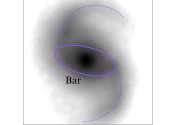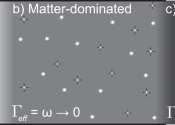The Universe is defined as everything that physically exists: the entirety of space and time, all forms of matter, energy and momentum, and the physical laws and constants that govern them. However, the term Universe may be used in slightly different contextual senses, denoting such concepts as the cosmos, the world or Nature.
Current interpretations of astronomical observations indicate that the age of the Universe is 13.73 (± 0.12) billion years, and that the diameter of the observable Universe is at least 93 billion light years, or 8.80 × 1026 metres. (It may seem paradoxical that two galaxies on opposite sides can be separated by 93 billion light years after only 13 billion years, since special relativity states that matter cannot be accelerated to exceed the speed of light in a localized region of space-time. However, according to general relativity, space can expand with no intrinsic limit on its rate; thus, two galaxies can separate more quickly than the speed of light if the space between them grows.) It is uncertain whether the size of the Universe is finite or infinite.
According to the prevailing scientific model of the Universe, known as the Big Bang, the Universe expanded from an extremely hot, dense phase called the Planck epoch, in which all the matter and energy of the observable Universe was concentrated. Since the Planck epoch, the Universe has been expanding to its present form, possibly with a brief period (less than 10-32 seconds) of cosmic inflation. Several independent experimental measurements support this theoretical expansion and, more generally, the Big Bang theory. Recent observations indicate that this expansion is accelerating because of the dark energy, and that most of the matter and energy in the Universe is fundamentally different from that observed on Earth and not directly observable. The imprecision of current observations has hindered predictions of the ultimate fate of the Universe.
Experiments and observations suggest that the Universe has been governed by the same physical laws and constants throughout its extent and history. The dominant force at cosmological distances is gravity, and general relativity is currently the most accurate theory of gravitation. The remaining three fundamental forces and all the known particles on which they act are described by the Standard Model. The Universe has at least three dimensions of space and one of time, although extremely small additional dimensions cannot be ruled out experimentally. Spacetime appears to be smooth and simply connected, and space has very small mean curvature, so that Euclidean geometry is accurate on the average throughout the Universe. Conversely, on a quantum scale spacetime is highly turbulent.
The word Universe is usually defined as encompassing everything. However, using an alternate definition, some have speculated that this "Universe" is just one of many disconnected "universes", which are collectively denoted as the multiverse. For example, in Bubble universe theory, there are an infinite variety of "universes", each with different physical constants. Similarly, in the many-worlds hypothesis, new "universes" are spawned with every quantum measurement. These universes are usually thought to be completely disconnected from our own and therefore impossible to detect experimentally.
Throughout recorded history, several cosmologies and cosmogonies have been proposed to account for observations of the Universe. The earliest quantitative geocentric models were developed by the ancient Greeks, who proposed that the Universe possesses infinite space and has existed eternally, but contains a single set of concentric spheres of finite size – corresponding to the fixed stars, the Sun and various planets – rotating about a spherical but unmoving Earth. Over the centuries, more precise observations and improved theories of gravity led to Copernicus' heliocentric model and the Newtonian model of the Solar System, respectively. Further improvements in astronomy led to the characterization of the Milky Way, and the discovery of other galaxies and the microwave background radiation; careful studies of the distribution of these galaxies and their spectral lines have led to much of modern cosmology.








